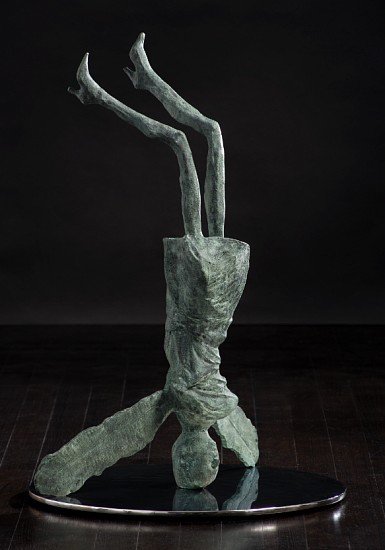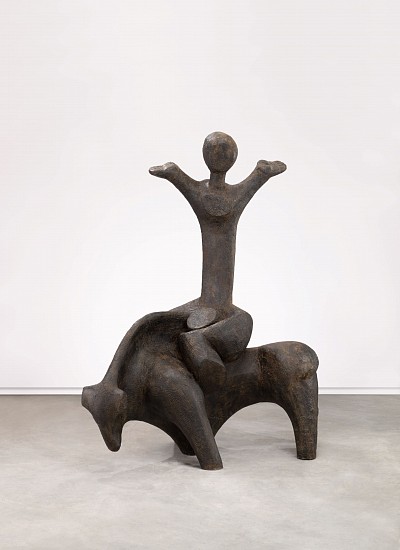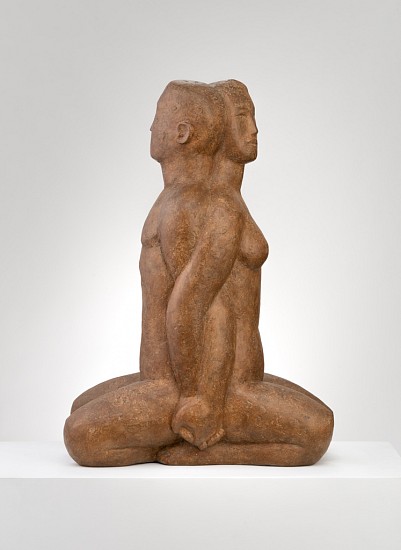SUMMER SCULPTURE EXHIBITION | RIVERHILL GARDENS
David Bowie once said of this artist – “Everyone should own a Beezy Bailey”.
One of South Africa’s most colourful and celebrated artists, Beezy Bailey is an artist set alight by the need to find expression for his creativity. Painter, sculptor, printmaker, performance artist, surrealist, collaborator, iconoclast – Bailey’s artistic practice defies easy categorization.
Many of the ideas and imagery for Bailey’s work emerge from dreams, the subconscious and a tireless imagination. Bailey’s father was a RAF pilot and his grandmother an outstanding female aviator who flew a pioneering solo flight from London to Cape Town and back in 1928.
This gives some context to the many references to rising, falling and floating in Bailey’s art. Flight in all its different meanings clearly entered his imagination at an early stage, and never left his dreams
Bailey’s fallen angel appears to be falling, floating and flying all at once - its head rooted to the earth, its reflection simultaneously floating in the clouds ….
Deborah Bell is one of South Africa’s most celebrated contemporary artists.
Bell has called these silent and seemingly ancient figures Invocation: The Ancient Ones. Made of cast bronze on marble bases resting on steel plinths, they evolved from a previous set of five monumental figures that Bell made in 2015 entitled Return of the Gods.
Draped in robes, the figures exude serenity as they drift, eyes closed, towards the horizon. Bell has described the smaller totemic figures resting on their heads as manifestations of one’s higher self, spirit, or soul.
Over the years the artist’s work has become increasingly concerned with surrender – to the higher self, the mystery of the universe, the simplicity of the present. Bell has described her artistic practice as a journey through time and material to show something that has always existed.
Deborah Bell is one of South Africa’s most eminent contemporary artists. In her iconography she draws from a range of cultures including African, Chinese, Egyptian, Greek, early Christian and European … as well as a range of philosophies, especially the Buddhist preoccupation with stillness and the shedding of attachment and the ego.
Bell recalls the genesis of this large-scale bronze sculpture like this…. “About 20 years ago, when I was moving out to the country from Johannesburg, I had the opportunity to buy a beautiful wooden mokoro (ma-kaw-raw - a type of canoe commonly used in the Okavango Delta, Botswana), which I thought would be perfect on the dam on my new property. Over the next few years, the boat appeared in many forms - etchings, paintings, and drawings. Carrying a single figure, they became the vehicle for some spiritual journey. I had always been interested in the form of a single figure standing at the back of such a canoe or gondolier - the aesthetics of it stirring some deep recognition and resonance within.
I decided to make a sculpture of this and set about forming the boat out of a steel armature and cement. I had two young Great Dane puppies that loved to climb into the structure - and the idea of two boats was born - one carrying a dog leading the other, with a standing figure. For some reason I didn’t complete the work at that time and the project was put on hold until returned to it a few years later. As I completed the work, my father died, and while standing at his funeral I realised that I had made that work for him, that this was his crossing, and that the timing of finishing the work was perfect. The dog was the guardian of his spirit, leading him across the river to the afterlife. The figure emerging out of his head was his greater self, spirit, or soul.
Deborah Bell is one of South Africa’s most celebrated contemporary artists.
Bell has called these silent and seemingly ancient figures Invocation: The Ancient Ones. Made of cast bronze on marble bases resting on steel plinths, they evolved from a previous set of five monumental figures that Bell made in 2015 entitled Return of the Gods.
Draped in robes, the figures exude serenity as they drift, eyes closed, towards the horizon. Bell has described the smaller totemic figures resting on their heads as manifestations of one’s higher self, spirit, or soul.
Over the years the artist’s work has become increasingly concerned with surrender – to the higher self, the mystery of the universe, the simplicity of the present. Bell has described her artistic practice as a journey through time and material to show something that has always existed.
Deborah Bell is one of South Africa’s most celebrated contemporary artists.
Bell has called these silent and seemingly ancient figures Invocation: The Ancient Ones. Made of cast bronze on marble bases resting on steel plinths, they evolved from a previous set of five monumental figures that Bell made in 2015 entitled Return of the Gods.
Draped in robes, the figures exude serenity as they drift, eyes closed, towards the horizon. Bell has described the smaller totemic figures resting on their heads as manifestations of one’s higher self, spirit, or soul.
Over the years the artist’s work has become increasingly concerned with surrender – to the higher self, the mystery of the universe, the simplicity of the present. Bell has described her artistic practice as a journey through time and material to show something that has always existed.
Beginning the sculpture trail is Guy du Toit’s “Protective Hare”. This sculpture has been cast in bronze. finished with a unique mottled patination and gold leaf on the tiny hare.
One of South Africa’s most accomplished sculptors, du Toit describes being ‘liberated’ by the advent of democracy in South Africa from having to concern himself and his art with the notions of identity, and he has happily turned his attention to pursuits such as reveling in form, concept and medium for their own sakes.
Full of pathos, Protective Hare gently cradles a tiny hare in its arms, shielding it from harm and a world of turmoil and uncertainty.
Du Toit’s hares have a lightness of being - they dance, they fly, they sit pondering their thoughts. They are like quick sketches in the landscape, something glimpsed out the corner of the eye, like a flash of truth.
Speelman Mahlangu was a South African artist whose practice encompassed both painting and sculpture.
Mahlangu’s imagery is uniquely African and his works often depict a dream world with its roots in tribal myths. His imagery draws on traditional practices inspired by his grandfather, who introduced him to the legends and symbolism of animals and ancestor sacrifice.
Riding the Bull is the artist’s unique take on an age-old sculptural subject – the horse and rider. In Mahlangu’s hands the rider gestures openly and exuberantly to the heavens as he sits aloft a powerful bull, the most precious and sacred beast in many tribal cultures.
Speelman Mahlangu was a South African artist whose uniquely African imagery draws on traditional practices inspired by his grandfather, who educated him in tribal folklore and symbolism of animals and ancestor sacrifice.
This worked entitled, The Rider, continues the artist’s exploration of the horse and rider motif. In Mahlangu’s hands both the rider and his mythical beast are synchronised in their gesture skywards, straining with vitality as if they might lift off…
Olivia Musgrave was born in Dublin to an Irish father and Greek mother. Her work is taken both from life and from the imagination where she draws inspiration from Greek mythology, as well as influences from 20th Century Italian sculptors most notably Marino Marini.
This trio of sculptures are Musgrave’s take on the three goddesses of fate who personify the inescapable destiny of humankind. According to Greek mythology, the Fates assigned to every person his or her fate.
- Clotho was the "the spinner," who spun the thread of life
- Lachesis (la·kuh·suhs) was the “apportioner of lots” who measured it
- Atropos was the goddess who cut it short.
Reminiscent of the monolithic human heads carved by the Rapa Nui people on Easter Island, Musgrave’s Fates have a sense of timelessness and peacefulness - indeed a calm resignation to their inescapable fate.
Olivia Musgrave was born in Dublin to an Irish father and Greek mother. Her work is taken both from life and from the imagination where she draws inspiration from Greek mythology, as well as influences from 20th Century Italian sculptors most notably Marino Marini.
This trio of sculptures are Musgrave’s take on the three goddesses of fate who personify the inescapable destiny of humankind. According to Greek mythology, the Fates assigned to every person his or her fate.
- Clotho was the "the spinner," who spun the thread of life
- Lachesis (la·kuh·suhs) was the “apportioner of lots” who measured it
- Atropos was the goddess who cut it short.
Reminiscent of the monolithic human heads carved by the Rapa Nui people on Easter Island, Musgrave’s Fates have a sense of timelessness and peacefulness - indeed a calm resignation to their inescapable fate.
Olivia Musgrave was born in Dublin to an Irish father and Greek mother. Her work is taken both from life and from the imagination where she draws inspiration from Greek mythology, as well as influences from 20th Century Italian sculptors most notably Marino Marini.
This trio of sculptures are Musgrave’s take on the three goddesses of fate who personify the inescapable destiny of humankind. According to Greek mythology, the Fates assigned to every person his or her fate.
- Clotho was the "the spinner," who spun the thread of life
- Lachesis (la·kuh·suhs) was the “apportioner of lots” who measured it
- Atropos was the goddess who cut it short.
Reminiscent of the monolithic human heads carved by the Rapa Nui people on Easter Island, Musgrave’s Fates have a sense of timelessness and peacefulness - indeed a calm resignation to their inescapable fate.
Acclaimed South African artist, Lionel Smit is best known for his contemporary portraiture executed through monumental canvases and sculptures. Now 40, Smit has been sculpting since he was a child, spending his days in and around his sculptor father’s studio.
Smit’s sculptures are often highly textured like this one, entitled Surge, where the hand - and tools - of the artist are clearly evident in the finished bronze.
Smit is both a painter and sculptor and has explored on canvas, paper and here in clay a version of the Janus head but Smit instead creates a double portrait, one face looking skywards and the other looking towards the earth. A simple yet powerful metaphor for life.
Florian Wozniak’s practice has been described as ‘looking at people through the eyes of a poet’ and the artist maintains that the true prize is the satisfaction of ‘distilling something of value into a poetic image.’
The human form is at the heart of Wozniak’s expression. His work has an earthiness of form, but his sensuous, voluptuously proportioned sculptures often depict human beings in relationship with each other and the wider world.
His sculptures are infused with a sense of serenity which permeates the physical spaces that his sculptures inhabit.
There is a tenderness about this work entitled Couple – the figures look upwards and outwards, facing the outside world while holding and supporting each other, their arms intertwined and their combined mass rooting them to the earth.
































































